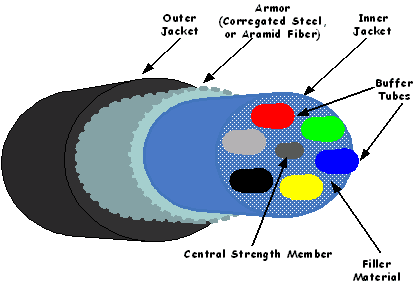4.4 Fiber Optic Cable
Fiber optic cabling consists of a center glass core surrounded by several layers of protective materials. It transmits light rather than electronic signals eliminating the problem of electrical interference. This makes it ideal for certain environments that contain a large amount of electrical interference. It has also made it the standard for connecting networks between buildings, due to its immunity to the effects of moisture and lighting.
Fiber optic cable has
the ability to transmit signals over much longer distances than coaxial and
twisted pair. It also has the capability to carry information at vastly greater
speeds. This capacity broadens communication possibilities to include services
such as video conferencing and interactive services. The cost of fiber optic
cabling is comparable to copper cabling; however, it is more difficult to
install and modify. 10BaseF refers to the specifications for fiber optic cable
carrying Ethernet signals.
The center core of fiber
cables is made from glass or plastic fibers. A plastic coating then
cushions the fiber center, and kevlar fibers help to strengthen the cables and
prevent breakage. The outer insulating jacket made of teflon or PVC.
 |
| Fiber optic cable |
There are two common
types of fiber cables -- single mode and multimode. Multimode cable has a
larger diameter; however, both cables provide high bandwidth at high speeds.
Single mode can provide more distance, but it is more expensive.
Cable
Type
|
|
10BaseT
|
Unshielded Twisted Pair
|
10Base2
|
Thin Coaxial
|
10Base5
|
Thick Coaxial
|
100BaseT
|
Unshielded Twisted Pair
|
100BaseFX
|
Fiber Optic
|
100BaseBX
|
Single mode Fiber
|
100BaseSX
|
Multimode Fiber
|
1000BaseT
|
Unshielded Twisted Pair
|
1000BaseFX
|
Fiber Optic
|
1000BaseBX
|
Single mode Fiber
|
1000BaseSX
|
Multimode Fiber
|
No comments:
Post a Comment